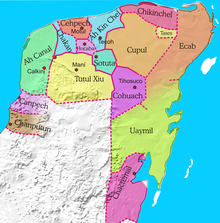Cocom (dynasty)

Cocom , rare Kokom is the name of a post-classical princely family of the Maya of Yucatan . The family continues to the present day.
history
The first written message from Cocom comes from Chichén Itzá . In 870, K'ak'upakal K'awiil, an outstanding personality in Chichén Itzá, K'inich Jun Pik To'ok ' , ruler of Ek Balam , and an apparently equal member of the Cocom family carried out a fire ceremony together. In the building in Chichén Itzá, now known as Akab Dzib , the owner Yahawal Cho 'K'ak' describes himself as a member of the Cocom family. But other inscriptions from unidentified buildings also relate them to the Cocom.
According to the Chilam Balam , the Cocom prince Hunak Ke'el , ruler ( Halach Huinik ) and possibly also founder of Ich Paa , was captured by the Itzá around the year 1194 and thrown into the cenote of Chichén Itzá as a human sacrifice on behalf of Chac Xib Chac . However, he survived and started the war that led to the destruction of Chichén Itzá. The establishment of the so-called League of Mayapán is attributed to the same . A dominance of the Cocom in Yucatan was ended by a rebellion 1441–1461 led by Ah Xupan Xiu , the ruling prince of Maní from the Tutul Xiu family , and led to the destruction of Mayapan. Almost all members of the Cocom family fell victim to the uprising.
Only one son survived, who stayed abroad and initially settled in Tibolon, but then founded Sotuta . This place, which like Maní is still inhabited today, became the residential city of the principality of the same name, which was one of the most important of 16 indigenous jurisdictions on the Yucatan at the time of the arrival of the Spaniards . The Cocom were in irreconcilable war with the Tutul Xiu in the following period. For example, a group of Xiu pilgrims who wanted to make sacrifices at the sacred cenote of Chichén Itzá to end a drought period are said to have been killed by the Cocom in their sleep. However, the Principality of Sotuta was also at constant war with the neighboring states of Hocabá and Ah Kin Chel .
While u. a. the Tutul Xiu had allied with the Spaniards, the Cocom led several uprisings. Nachi Cocom († 1562), ruler of Sotuta and grandson of the last ruler of Mayapan, was one of the most important and last resistors. On June 11, 1541 he was defeated, leading a united Maya army, against Francisco de Montejo y León and his indigenous auxiliary troops at Tixkokob . After his baptism in the name of Juan , he made valuable information available to Diego de Landa for his work "Relación de las cosas de Yucatán", written around 1566. His brother Lorenzo Cocom succeeded him as head of the family, but in order to avoid embarrassing questioning , after a year of reign he took his own life after he was accused of sacrificing people in Sotuta. He was followed by Nachi Cocom's son, who was named governor of Sotuta from 1565 to 1581. He is said to have been a very smart and prudent man who also spoke fluent Spanish. His family held the governor's office in Sotuta until the end of the 18th century.
Relatives
- Hunak Ke'el († after 1194), Halach Huinik of Mayapan and founder of the League of Mayapan
- Nachi Cocom († 1560/1562), Halach Huinik of Sotuta and leader of the resistance against the Conquista
- Heriberto (Beto) Cocom, President of AdEP, a support company for the preservation and development of El Pilar
- Dr. Juan Castillo Cocom, anthropologist
literature
- Diego de Landa : Relacion de las cosas de Yucatán. P. 15–68 online version, Spanish (PDF; 513 kB)
- Ralph L. Roys : The Political Geography of the Yucatan Maya. Washington 1957, pp. 92-101
- Berthold Riese : The Maya: History, Culture, Religion. 6., through. Aufl., Beck, Munich 2006, pp. 109, 111-113, 120; ISBN 3-406-46264-2
- Miloslav Stingl : Indians before Columbus. Leipzig • Jena • Berlin 1982, pp. 219, 223
Individual evidence
- ↑ Nikolai Grube , Ruth Krochok: Reading between the lines; hieroglyphic texts from Chichén Itzá and its neighbors . In: Twin Tollans: Chichén Itzá, Tula, and the epiclassic to early postclassic Mesoamerican world , ed. by Jeff Karl Kowalski, Cynthia Kristan-Graham. Dumbarton Oaks, Washington 2007, ISBN 978-0-88402-323-4 , pp. 205-249.
- ↑ Alexander W. Voss, H. Jürgen Kremer: K'ak'-u-pakal, Hun-pik-tok 'and the Kokom: The political organization of Chichén Itzá . In: Pierre Robert Colas (Ed.) The Sacred and the Profane: Architecture and Identity in the Maya Lowlands . Acta Mesoamericana, no.10 . Markt Schwaben, Saurwein 2000, ISBN 3-931419-04-5 .
- ^ Sylvanus Griswold Morley : The ancient Maya. Stanford University Press, Stanford 1956 (3rd edition).
- ↑ Cronica de Oxkutzcab from 1538
- ↑ Short biography of Dr. Juan Castillo Cocom

